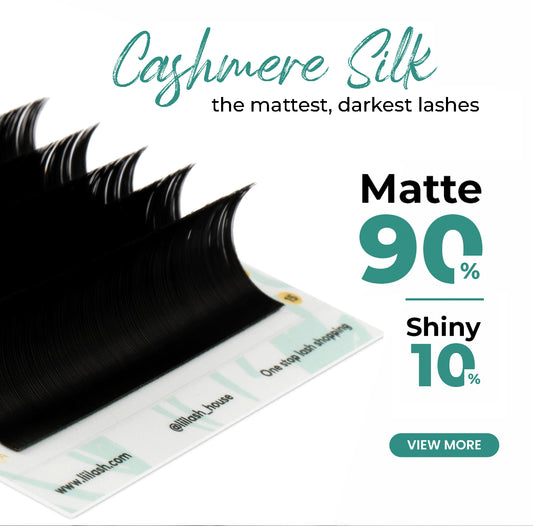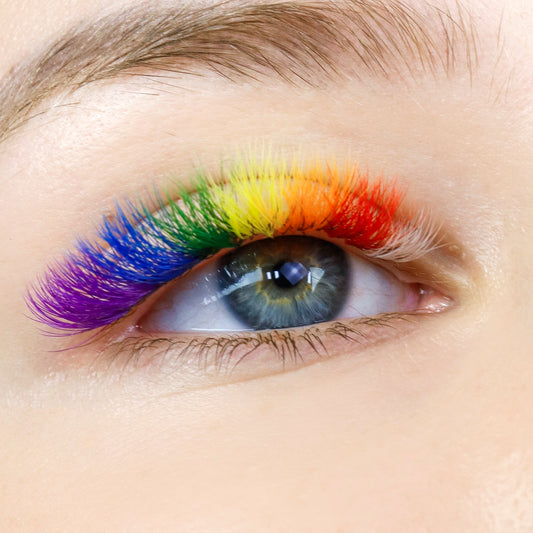10 Reasons Why You Shouldn't Do DIY Lash Extensions
Lash extensions are a game-changer offering you the freedom to rock from natural to glam look that lasts for months, but sometimes the salon isn’t an option, and the DIY route seems like a time and money saver.
The question is: Is it worth the risk, though? Lies under allure, at-home lash extension applications can have numerous hidden risks that can severely harm your health. Join us in this blog as we uncover why DIY lash extensions might not be your best call.
And stay til the end as we've got you up with all the care tips to keep those lashes fabulous at home. Find out what to do when eye problems occur.
What is DIY lash extensions?

Lash extensions, made of synthetic or natural fibers, get individually applied to your natural lashes with special adhesive. Normally it's a salon thing, but when the pandemic hit, salon visits were impossible; hence, DIY became everything. Even after the pandemic, the DIY trend stuck around, gaining steam thanks to its undeniable benefits.
Well, it's a money-saver compared to professional services, save valuable time otherwise spent commuting, and offer you complete control over your lash aesthetic. You can choose any style and experiment with different looks to your likings. Moreover, it’s always fun to DO-IT-YOURSELF!
How to apply lash extension at home?
What you need
Commonly, if you have your lash extension done by professionals, they will be the ones who prepare all tools and equipment needed. All you need is to tell technicians what styles you want, lay on the bed and relax while having your lashes applied. But if enjoy Do-it-yourself method, here’s what you need:
- Lash Extensions: These come in different lengths, curls, and thicknesses. Pick ones that match your natural lashes and desired style.
Discover our Classic lashes collection - an ideal starting point for beginners looking to elevate their lash game.
- Lash Glue/Adhesive: Look for a low-fume, sensitive adhesive. If you're new at this, go for a slower-drying one (around 3-5 seconds) to avoid a glue dry-up disaster
- Lash Tweezers Set: Look for a set with straight tweezers for isolation and curved ones for picking and applying the extensions.
- Lash Brush and Comb: These help shape and style your lashes, keeping them untangled.
- Lash Cleanser: Use this to ensure your lashes are clean and free from dirt, oils, and residue before application.
- Lash Remover: For those moments when things don't go as planned or when you want to remove the extensions.
- Lash Tape or Eye Pads: These are essential for securing and isolating your lower lashes to prevent irritation during the application process. They also can be used to lift stretch, spread your eyes, make application easier and faster.
DIY Lash extensions: Step-by-step process
Lash extension application involve several steps to ensure the safest and most beautiful result, but here’s the streamlined one for you:
- Cleansing: First things first - cleanse your natural lashes with a lash cleanser. This sets the stage for better adhesion and a cleaner canvas.
- Lower Lash Protection: Protect lower lashes! Place eye pads or lash tapes to isolate and shield them to prevent irritation and damage during the process.
- Application: Isolate a single natural lash by tweezers. Then dip the extension carefully into specialized adhesive/glue. Now, gently place each extension onto your natural lashes. Hold it for a sec to let the glue set and secure the extension in its perfect spot.
- Start and Repeat: Begin from the outer corner of your eye and work your way in. Repeat this delicate process until you achieve your desired look.

For a clearer insight, check out this YouTube tutorial where Ms. Xao Yang do her own DIY lash extensions at home!
Dangerous risks from DIY Lash Extensions
Convenient and cost-effective as it be, DIY lash extensions without the right expertise contain hidden risky threats. Understanding the risks is crucial for your safety.
Burn or allergic reaction to Adhesive
The adhesive used in lash extensions, Cyanoacrylate, is a star in professional hands but can pose risks if mishandled. If it accidentally touches your skin or eyes, it might lead to burns or allergic reactions. Without proper training, managing this adhesive becomes quite risky.
Lack of Expertise
The lack of expertise brings concerns about product selection and handling tools like sharp-tipped tweezers. Choosing low-quality products or using tools improperly can be risky, especially given the delicate nature of the eye area.
All tweezers used for lash extensions have very sharp tips so it's safer to work with your eyes closed during application to avoid accidents. When you're doing this at home, you have to keep one eye open or sometimes it takes two, and with a mirror, it can be a bit trickier to maintain perfect accuracy. A slip with those sharp tweezers could accidentally poke your eye due to the reduced precision when working with a mirror.

Source: GTEX Lash Tweezers
High risk of infections
There's also the possibility of allergic reactions or infections. Your skin might not react well to the glue or lashes, leading to redness, swelling, or potentially eye infections. That's why professionals always conduct patch tests for you before a full application.

Disappointment of DIY outcome
Lastly, Imagine investing your time and effort into DIY lash extensions only to end up dissatisfied with the results. Worse yet, if things go wrong, removing those extensions without professional guidance can increase the risk of your real lash loss, irritation or eye infection.
Common mistakes and how to avoid
1. Ignore instructions:
- Mistake: Ignoring or not thoroughly understanding the instructions provided with the lash extension kit.
- Consequence: Improper application leading to discomfort, irritation, or damage to natural lashes.
- Avoidance: Carefully read and follow all instructions step by step. Watch tutorials and seek guidance if unsure.
2. Not cleanse your natural lashes
- Mistake: Skipping proper cleansing and preparation of natural lashes before applying extensions.
- Consequence: Extensions might not adhere well, causing premature fallout or discomfort.
- Avoidance: Cleanse lashes with an oil-free solution to remove makeup residue and oils, ensuring a clean surface for application.
3. Using wrong tools or adhesives
- Mistake: Using inappropriate tools or low-quality adhesives in an uncontrolled environment (like a dusty room or a bathroom).
- Consequence: Poor adhesion, risk of allergic reactions, or potential damage due to unhygienic conditions.
- Avoidance: Use tools specifically designed for lash extension application and work in a clean, controlled environment to minimize contamination.
4. Reject patch testing in advance
- Mistake: Neglecting to perform a patch test to check for allergic reactions to adhesives or other products.
- Consequence: Allergic reactions ranging from mild irritation to severe swelling or redness.
- Avoidance: Conduct a patch test by applying a small amount of adhesive behind the ear or on the inner arm and wait for 24 hours for any adverse reactions before full application.
5. Excessive acts cause damages
- Mistake: Applying excessive pressure or using harsh techniques during extension application.
- Consequence: Damage to natural lashes, discomfort, or misaligned extensions.
- Avoidance: Apply extensions gently, ensuring they are properly separated and adhered without tugging or pulling on natural lashes.
6. Improper application
Failing to isolate each natural lash properly or assuming it's done but releasing them before the glue fully dries can cause lashes to stick together. This leads to lash fallout and difficulty in brushing them, as they get stuck and eventually fall out. Lashes grow at different stages, and if one is ready to shed but is stuck to another, it won't shed naturally.
Additionally, positioning lashes too close to the lash line may irritate the skin, potentially leading to infections. The potent adhesives, intended solely for professional use, can induce allergic reactions due to their high fumes.
Safety Tips:
- Work in a well-lit, clean area with all necessary tools within reach.
- Be patient and take your time; rushing can lead to mistakes.
- Use a mirror for close-up precision and better control.
- If uncertain, seek advice from professionals or watch tutorials for guidance.
- In case of discomfort or irritation during or after application, remove the extensions immediately and seek professional help if needed.
Taking these steps doesn't eliminate the risks entirely, but it may help you stay safe and increase the odds that you'll be happy with your results.
Hence, having professional expertise isn't just about luxury; it's about ensuring your safety. Trusting skilled hands ensures a fantastic outcome without compromising your eye health or risking unwanted reactions.
HOW TO FIND A RELIABLE SALON
Remember, while at-home application is possible, it's crucial to prioritize safety and precision to prevent potential damage to your natural lashes and ensure a comfortable experience.
Instead of doing your own eyelash extensions, seek out a qualified professional. Here are a few tips to help you find a skilled one:
- Do quick research: Find a good salon by asking for recommendations, checking online reviews, looking at before-and-after photos from previous clients, and even visiting before your appointment.
- Check tech qualifications. Ask about the eyelash technician's training, certification and experience. Find out how long the tech has been doing lash extensions.
- Look at licensing. Verify that the technician meets your state's licensing requirements. Depending on the state, they may need a specific eyelash extension technician license or an aesthetician or cosmetology license.
- Scrutinize the glue. Ask ahead of time for the type of glue and a list of ingredients, and look for allergens like formaldehyde. Ask the salon to apply a bit of glue to the inside of your wrist to test for a reaction.
Conclusion
In conclusion, while the allure of DIY lash extensions might seem appealing, the risks involved, from adhesive mishaps to potential allergic reactions and disappointing results, emphasize the importance of entrusting professionals with this intricate task. Safety, precision, and the health of your lashes outweigh the DIY adventure, making professional expertise an invaluable choice for a flawless and risk-free lash enhancement journey!
YOU MAY ALSO LIKE
Lash Extension 101: A Comprehensive Guide







